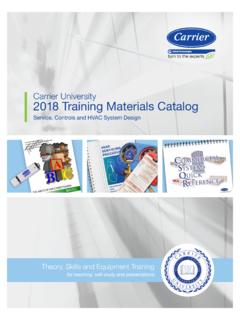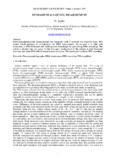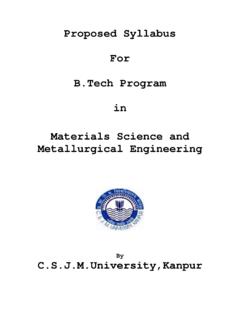Transcription of Fundamentals of Electrical Drive Controls
1 UNESCO EOLSSSAMPLE CHAPTERSELECTRICAL ENGINEERING Fundamentals of Electrical Drive Controls Josko Deur and Danijel Pavkovic Encyclopedia of Life Support Systems (EOLSS) Fundamentals OF Electrical Drive Controls Jo ko Deur and Danijel Pavkovi University of Zagreb, Faculty of Mechanical Engineering and Naval Architecture, I. Lu i a 5, HR-10002 Zagreb, Croatia Keywords: Electrical drives, control , modeling, DC motor, permanent-magnet synchronous motor, cascade control , chopper, sensors, speed control , position control , pointing, tracking, friction, compliance, backlash, state control , nonlinear compensation. Contents 1. Introduction 2. Elements of controlled Electrical Drive Separately-excited DC motor Electronic power converters Sensors Electronic control unit and control algorithms 3.
2 Adjustment of DC motor speed Speed adjustment by armature resistance control Speed adjustment by armature voltage and field control 4. Design of DC Drive cascade control system Cascade control structure Damping optimum criterion Armature current control Speed control Position control 5. Design of tracking system Tracking of a-priori known reference Tracking of a-priori unknown reference 6. control of permanent-magnet synchronous motor Modeling of motor control 7. Compensation of transmission compliance, friction, and backlash effects Model of two-mass elastic system with friction and backlash Compliance compensation Friction compensation Backlash compensation 8. Conclusion Appendix: control system parameter values Glossary Bibliography Biographical Sketches Summary Controlled Electrical drives can be regarded as the most flexible and efficient source of controlled mechanical power.
3 Understanding and developing the controlled Electrical UNESCO EOLSSSAMPLE CHAPTERSELECTRICAL ENGINEERING Fundamentals of Electrical Drive Controls Josko Deur and Danijel Pavkovic Encyclopedia of Life Support Systems (EOLSS) Drive systems require a multi-disciplinary knowledge, starting from Electrical machine theory, through electronic power converter technology to control system design techniques. This article gives a systematic overview of elements of a controlled Electrical Drive with emphasis on the control system design. The basic procedure of feedback and feedforward cascade control system design is presented for the separately-excited DC motor. It is then demonstrated that the basic principle of current/torque control can be applied to AC machines modeled in the rotational field coordinate frame, while the superimposed speed and position controller structure remains the same as with the DC motor.
4 Finally, a notable attention is paid to analysis of transmission compliance, friction, and backlash effects, and their compensation by means of advanced control algorithms. 1. Introduction Electrical drives represent a dominant source of mechanical power in various applications in production, material handling, and process industries. Applying the feedback control techniques to Electrical drives substantially improves their performance in terms of achieving precise and fast motion control (servo- control ) with a high efficiency. Traditionally, the controlled Electrical drives were based on direct-current (DC) motors and analog controllers. However, the rapid development of power electronics and microprocessor technology in the last three decades has propelled application of servo- control to brush-less, alternating-current (AC) drives, and provided implementation of advanced motion control algorithms including compensation of transmission compliance, friction, and backlash effects.
5 The overall control performance, efficiency, reliability, and availability of the controlled Electrical drives have been substantially improved, thus accelerating their penetration into various engineering applications. This article presents an overview of controlled Electrical Drive technology with emphasis on control system design. The presentation is based on the separately-excited DC motor, since control of this motor can be easily understood and readily extended to AC motors. First, the elements of a controlled Electrical Drive are described (Section 2), which include DC motor and its mathematical model, electronic power converters, sensors, and electronic control units including the basic control algorithms. Next, the steady-state form of DC motor model is used to describe the motor speed adjustment (or open-loop control ) in the regions below and above the rated speed, as well as the controlled starting and regenerative braking of the motor (Section 3).
6 This serves as a basis for presenting a cascade structure of motor feedback control , including optimal tuning of current, speed, and position controllers (Section 4). For tracking applications, the feedback system is extended by feedforward paths or a feedforward compensator, in order to reduce the dynamic tracking error (Section 5). Section 6 shows, on an example of permanent-magnet synchronous motor (PMSM), how the naturally decoupled armature and field control of DC motor can be applied to the coupled dynamics of three-phase AC motors. Finally, Section 7 analyzes influences of transmission insufficiencies related to compliance, friction and backlash effects on the static and dynamic behavior of a servodrive, and presents control algorithms for compensating these effects.
7 The theoretical discussions are illustrated by a number of computer simulation results. UNESCO EOLSSSAMPLE CHAPTERSELECTRICAL ENGINEERING Fundamentals of Electrical Drive Controls Josko Deur and Danijel Pavkovic Encyclopedia of Life Support Systems (EOLSS) 2. Elements of Controlled Electrical Drive Figure 1 shows the structural block diagram of a controlled Electrical Drive . An Electrical motor is coupled to a working mechanism in order to provide a transfer of mechanical power. The main additional features of controlled Electrical drives compared to their conventional counterparts are: (i) the power transfer is made time variant/controllable using an electronic power converter , and (ii) the Drive motion can be controlled in a precise manner based on the use of feedback paths containing sensors and electronic control unit.
8 The control tasks can be different, starting from current control (corresponding to open-loop torque/force control ), through speed and position control , and towards force control . Normally, the controlled power flows from the Electrical grid to the working mechanism. However, during transients or occasional continuous braking intervals, the motor switches to a generator mode and the power flows back to the grid. If the power converter does not support the regenerative braking feature (typically in low-power drives), the braking power is dissipated on a braking resistor. Figure 1. Structural block diagram of controlled Electrical Drive . Separately-Excited DC Motor Direct-current (DC) motor (see cross-section schematic in Fig. 2a) consists of a magnetic field flux (excitation) circuit (placed on the stator), armature circuit (placed on the rotor), and a commutator which inverts the current in an armature coil whenever it passes through the neutral zone that is perpendicular to the stator field axis.
9 The power is transferred to the armature through brushes that are fixed in the neutral zone and leaned to the commutator. The excitation and armature circuits can be connected separately from each other, or a series or parallel connection can be utilized instead. The separately-excited DC motors are mostly used in controlled drives, owing to the possibility of independent field and armature current control and related superior control features in a wide speed range. UNESCO EOLSSSAMPLE CHAPTERSELECTRICAL ENGINEERING Fundamentals of Electrical Drive Controls Josko Deur and Danijel Pavkovic Encyclopedia of Life Support Systems (EOLSS) Figure 2. Simplified cross-section schematic (a) and equivalent scheme of separately-excited DC motor. Dynamic Model Figure 2b shows an equivalent scheme of the separately-excited DC motor.
10 The stator magnetic flux acts upon the armature current ai, thus producing the motor torque. On the other hand, when the rotor rotates, the voltage e(back electromotive force, EMF) is induced in the armature winding. The motor dynamics are described by the following set of differential equations (see Nomenclature), given in both time (t) and Laplace (s) domain: aaaaaa aaaa()()()()( )( )( ) ( )di tu tRi tLetu sRi s Lsi s e sdt=+ + =+ + (1a) e()() ()etKtt = (1b) mlm l()()()()()()dtJmtmtJssmsmsdt = = (1c) mma()() ()mt K tit= (1d) MMMM MM MM M(())()()()()()ditu t Ri t Nu s Ri s N s sdt =+ =+ (1e)

















